Cats and play
We challenge you to watch a kitten playing with a leaf and not feel some of her joy. Many psychologists recommend that their patients try to ‘live in the moment’ and to practise ‘mindfulness’ by focusing on the present’ in order to relieve their stress and anxiety. That kitten, as with all animals, is completely ‘in the moment’, and so are we if we focus on her playing. The kitten is playing naturally and instinctively, but it is not solely just for fun. It is part of Nature’s plan towards her independence and survival.
CATS
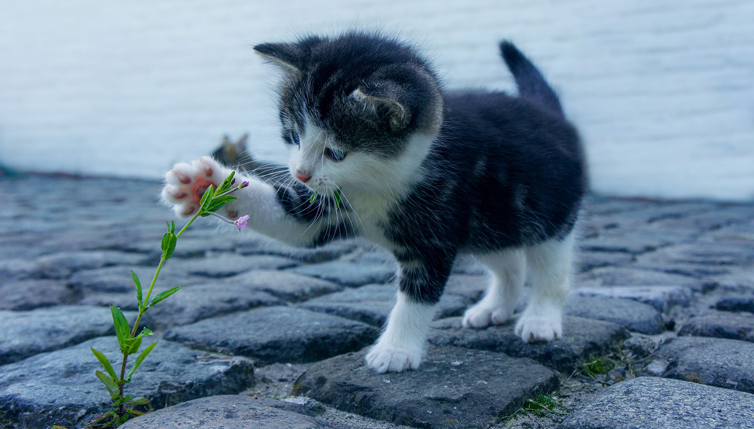
You’ve probably heard people (not cat owners) say that they’re going to get a cat because they’re so much less maintenance than dogs. It’s true that they don’t need much space in the house, walks, grooming and bathing (cats come with an inbuilt grooming device) and, once they get the hang of it, they’ll never relieve themselves on your Persian rug. But we must not assume that because they’re generally easier to care for than dogs, they need less attention than dogs. The truth is that they benefit greatly from interactive play, just as dogs do.
Why play?
WHAT DO THE SCIENTISTS SAY?
Many of us assume that because cat play resembles hunting, then it must have the purpose of ensuring that the cat will be a better hunter. This, to a certain extent, is true, but some behavioural scientists don’t totally agree. They have conducted research which shows that play doesn’t particularly help them with their later hunting skills. It is chasing real prey that helps them to become good hunters. However, there is no doubt that cats’ play behaviours are similar to hunting techniques. Cats’ games are predatory games.
There are many questions here concerning cat play, that need answers:
When and how does play transition into aggression?
What sort of play do cats prefer?
Is play important for cats’ survival? Otherwise, why do they do it?
More research is clearly needed to answer these intriguing questions.
One important thing, however, that cat behaviourists do know is that play is important for cats to develop into…well, functional cats. Lack of physical and cognitive stimulation can certainly create, for example, an overly-aggressive or anxiety-ridden cat. Scientists also know that a happy, healthy and contented cat has probably been encouraged, through play, to become involved in ‘species-specific’ behaviours. In the wild, cats and their ancestors would have had mothers to encourage play; with domestic cats, you are IT.
WHAT DO WE NEED TO KNOW?
What we, as cat owners (BTW, any cat person knows that cats are never ‘owned’; cats are the owners, we are their slaves) need to know then is:
How can I provide the right context and environment to encourage my cat to adopt cat-like ‘species-specific’ behaviours?
So, apart from play being essential for cats to become … cats, what are the other reasons why play is important for both Old Catzilla and for little Cupcake?
STRETCH THOSE LAZY, FELINE MUSCLES!
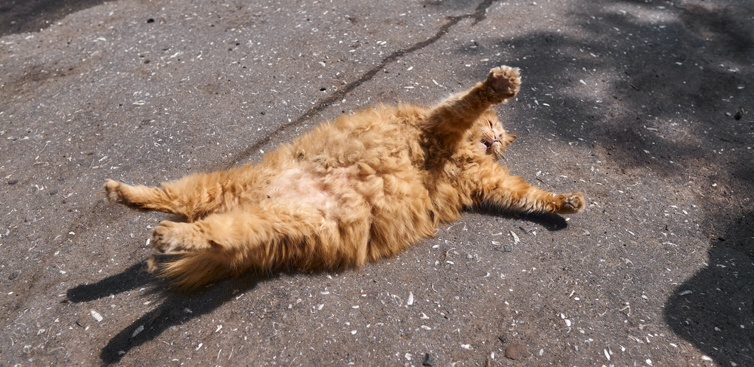
Many of us are feeling that, over the various lockdown regulations, we may have put on just a teensy-weensy bit of weight. Exercise is important for us, but it is equally important for your cat’s well-being, physically and mentally. Movement (as so many of us have discovered over the past year) helps to keep weight down, keeps us fit and healthy, helps our psychological well-being and relieves boredom. The same goes for our cats.
Catzilla, spread like a pudding on his bed, hasn’t inherited his, shall we say, generous figure. Cats are naturally lean and muscular. He’s most probably overweight, lazy, unhealthy and very expensive – consider his food and vets’ bills. He probably hardly ever goes out: he doesn’t have to when all his needs are met, including the ownership of a fancy litter tray/house, indoors. But, we hesitate to point this out, it’s not his fault. He has at least one enabler…
Dogs will of course very happily and enthusiastically, drag you around the streets on a leash, but cats generally don’t work that way. Besides, enthusiasm is rarely an attribute of superior beings. Cats can, in fact, be trained to walk sedately on a leash, but they have to be trained from young and some will simply not allow it.
BONDING
Play with humans creates a strong cat-human bond. Many of us see cats as being solitary creatures, but they do seem to need and crave love, attention and friendship from their humans. Playing with your cat, interacting with him/her on a daily basis, creates strong bonds, to the benefit of both parties.
STRESS RELIEF
Stress and anxiety are bad for us, and our cats, mentally and physically. Stress for a cat may result from denying him/her those opportunities to practise behaviours which define ‘catness’, like hunting, stalking and bonding. This obviously applies particularly to indoor cats. Behavioural problems may result, including obsessive-compulsive disorders, aggression and excessive spraying. Playing can help to de-stress an anxious cat, refocusing its mind on a pleasurable activity instead of suffering from increased anxiety, which may even lead to depression and physical illness.
AVOIDING BOREDOM
Cats, as all cat-slaves know, are highly-intelligent creatures who, like us, need challenges to get their brains into gear. Boredom breeds behaviour problems, anxiety and depression. We can distract ourselves and engage our brains with a book, a movie, a conversation with friends. Animals cannot. Playtime, with their favourite slave, will relieve and prevent the numbing boredom of a highly-intelligent brain.
Kittens and play
Who has not wondered at even the tiniest little puff-ball’s ability and excitement for batting a feathered toy tied to the end of a stick? Or in the pursuit of a very-threatening leaf? And isn’t it a joy to watch this? Play is usually the first behaviour that we recognise in kittens. It is vitally important for their physical, cognitive and social development. Their first play usually involves other members of the litter:- chasing and pawing each other. This is important for fostering social bonds. Then there is the natural progression to objects and play behaviour. The move towards independence has begun. When the kitten is alone and a leaf is no longer the exciting object it once was, that’s where you come in with your feathers on sticks and moving mice. You will both reap the rewards when the kitten becomes a happy, contented, loving and healthy cat.
Indoor cats
There are various reasons for keeping a cat indoors, eg to keep them safe from outdoor dangers; to protect wildlife; to stop a cat with an infectious illness from passing it on, eg feline HIV. Many people live in apartments or with living situations where it is essential to keep a cat indoors.
Playtime is essential for these cats, otherwise they will not be able to practise their natural, ‘species-specific’ behaviours, and might take out their frustration on your curtains. Play is important for these cats to get exercise, to keep them mentally and physically happy.
Object play
There are two main types of play: solitary, in which the cat plays with objects such as toys, paper bags, leaves, sticks, etc, and social, in which the cat plays with other cats, other animals, and you.
Like children, cats love toys. In object play, various inanimate objects are used to prompt play behaviour. The objects are usually provided by the slave. Even wild cats play with sticks, stones, leaves, etc. The cat will chase, throw, bite, catch and ‘kill’ the object, as if it is prey. In the wild, this play is important practise for engaging with prey and for providing food for the cat and his/her family. It is, quite literally, a matter of life and death.
TOYS FOR CATS
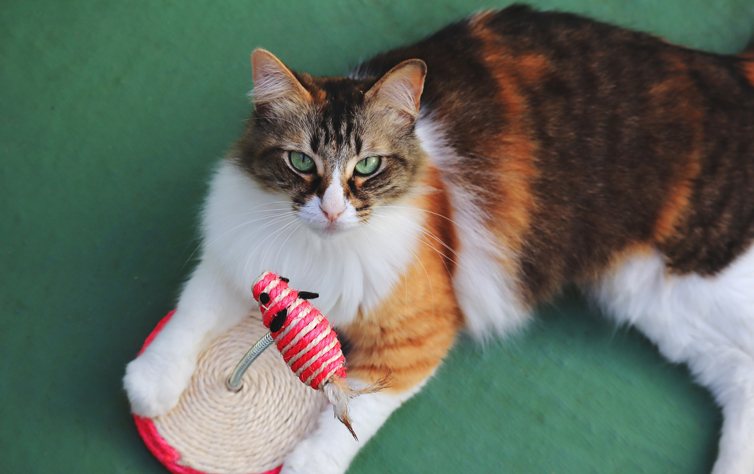
A variety of toys is needed. No child will play with the same toy for days on end. Neither will cats. These toys may be purchased and/or handmade. Check that all cat toys are safe. Look for any loose bits and pieces, eg bells, beads, ribbons, etc. Children’s toys are usually not suitable for cats. They are intended for little humans with pudgy fingers, who do not have sharp teeth and claws. Cats may chew and break them and get injured or ingest small pieces. Introduce new toys gradually and alternate them to avoid boredom.
Play simulates the feline instinct to hunt, so ‘moving’ toys will substitute for prey. Traditionally, many cats have been given the familiar, battery-powered (or attached to a string pulled by slave) mice. Research has shown that the more realistic these toys are, the better, eg plastic snakes and small animals. However, many of us have seen cats chasing a bit of rolled-up newspaper tied to a string. Your cat will be unable to resist stalking, chasing and pouncing on these. Feathers on a string attached to a stick are always a ‘hit’, and will require your cat to jump and stretch repeatedly. These can easily and cheaply be made.
When a cat is ‘home alone’ you should try to leave toys that he/she can throw around, chew (without being able to bite off chunks and eat them), chase (balls which rattle enticingly) and the solid rubber ‘treat holders’ which will engage your cat for long periods of time. Ensure that you wash these thoroughly after each chewing session.
Your vet will stock a variety of cat-friendly toys, which may be a bit more expensive, but will last and will be used repeatedly. You will also have the comfort of knowing that these toys will not harm your pet.
A CAT-FRIENDLY HOME
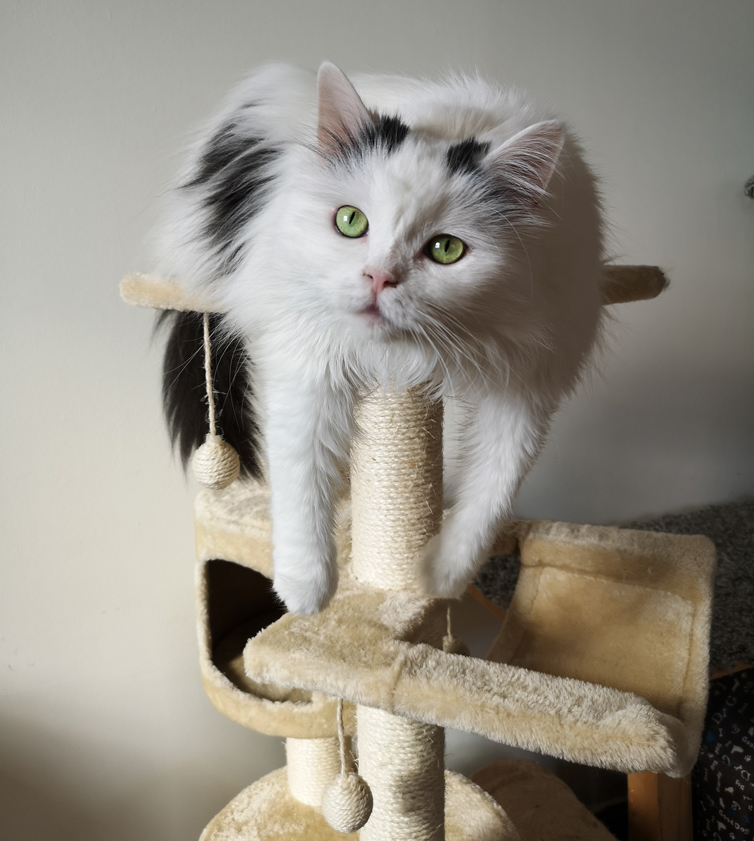
When you have a largely indoor cat to entertain, especially if you are away most days, then creating a cat-friendly space in your home is essential. Largely-outdoor cats will also appreciate this. Cats love to look down on everyone – it makes them look superior, which, as we all know, they are and it also makes them feel safe. Very elaborate structures can be seen online. There was a couple in America who virtually gave up their home to their collection of felines, with tunnels excavated from one room to another; ladders, perches and sleeping shelves were attached to the walls, and a live tree took over their lounge. There is absolutely no need to go to these lengths, of course. However, a couple of scratching posts (Try tying them to the legs of a table with cable ties.), a cat ‘tree’ and some boxes will provide plenty of playtime for your cat.
Cats also have an instinctive need for privacy, so ensure that you provide a couple of places for her to hide and feel safe.
How much playtime?
Cat behaviourists say that indoor cats (particularly) need ‘scheduled interactive playtime’: twice daily for around 15 minutes. We hear you, yelling: Get real! I’ve got 3 kids! I work full-time! I wouldn’t mind some leisure time myself! Remember though that the experts are only recommending what they see as ideal. Take into account the factors discussed above: age, weight and health (the cat’s not yours) must be considered. Old Fat Cat may need a bit of encouragement, so will possibly only need perhaps a few minutes of gentle play, twice a day. Little Puff-Ball will need no encouragement and will often initiate play with you herself.
Rough (Aggressive) Play
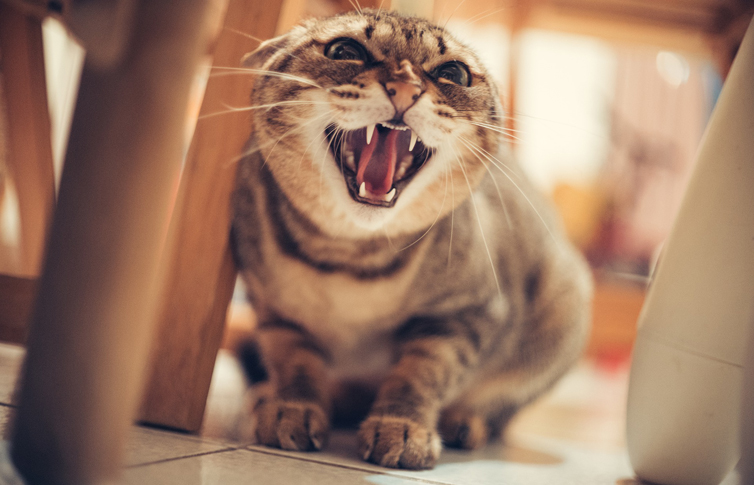
Much of cats’ play involves mock aggression, imitating the skills of a real-life predator. Sometimes though, biting and scratching may be involved, but you will soon be able to tell the difference between play-type aggression and the Real Thing. However, even play aggression may be seen, wrongly, by humans as ‘naughty’, especially when they are at the receiving end of sharp claws and teeth. Clearly, such rough play needs to be controlled and, preferably, eliminated.
- Your cat can work out some of his aggressive instincts on toys, which can simulate hunting. We know that they enjoy stalking, chasing and capturing moving toys.
- Several play sessions with you should be offered during the day, if possible, meeting both his need for predatory behaviour and tiring him out.
- If your cat is left alone doing nothing all day (if you don’t count the shredded curtains), he may work his frustration out on you with overly-rough play when you come home, carrying your shopping bags. Leave toys for him when you go out, especially objects which are new to him like paper bags and empty plastic milk and juice containers.
- Try not to let her take swipes at your hands and feet during play. Direct play onto a toy.
- If Puff-Ball develops a liking for taking swipes at your feet or ambushing you on the stairs, direct her attention to an object, which may even be a piece of paper.
- Solitary play, outside in a safe garden, where she can play and work off some energy and aggression, would be the ideal. But this is rarely possible for most of us, so a good substitute would be a large enclosure, containing branches, boxes for privacy and toys. It can be made of logs and wire and need not be expensive.
Please don’t punish your kitty for rough, aggressive play. He/she is doing what comes naturally and doesn’t know where the line between play and true aggression is drawn. He/she is not being ‘naughty’ – that is a human construct and does not apply to animals. If you hit your cat, she may think you are playing or she may become afraid of you, which is the last thing you want.
Health issues and play
Old Catzilla will need different play routines to little Puff-Ball, especially if the former is – how can we put this delicately? – fat. We suggest you consult your vet before introducing Fat Cat to play involving exercise. Usually it’s a case of ‘slowly and gently does it’ until he, hopefully, loses some weight.
If your cat has high blood pressure, heart problems or in fact any acute or chronic illness, consult your vet. Always watch for any breathing problems while playing, like shallow breathing or unusual panting. Either stop the play or slow it down. Consult your vet to be on the safe side.
Also remember that any parasites, internal or external, will affect your cat’s health, so be sure to get rid of the little nasties with Bravecto® for Cats. It is a safe flea and tick treatment, which provides up to 3 months of protection for cats and for kittens over 9 weeks of age. Remember that these parasites are present year-round. There is even Bravecto® Plus that protects kitty from ticks, fleas and heartworm for 3 months and provides a worm and mite treatment, all in one dose. Bravecto® has been proven not to interact with any other medication, for those cats that may be on treatment for any current illness.
Finally, the most important thing when you are bringing-up a cat (or when she is bringing you up) is that you both get great joy out of each other’s company. Just stop for a minute and watch her playing with leaves in the garden…
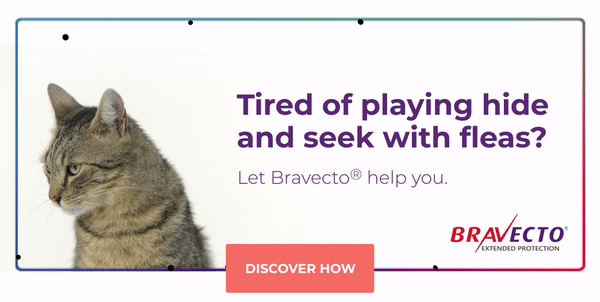
Subscribe to our Newsletter
Get to know your furry friend better! Sign up for all things dog- or cat-related.
The Hairy Facts about the dreaded hairball
12 April 2021
Help! My dog’s barking mad! Volume 2
12 April 2021
Your Itchy, Scratchy Cat – All About Cat Skin Problems
12 April 2021
The Dog’s Diet: A Bone of contention?
01 April 2021
Mango Fly Worms: How to Spot and Eliminate them
Posted on November 28,2019
Managing Mange And Mites In Your Dog
Posted on June 11,2018
Why Do Cats Purr and How? Learn What Your Cat Is Saying
Posted on October 14,2020
How to Get Rid of Ear Mites in Dogs
Posted on November 06,2019









